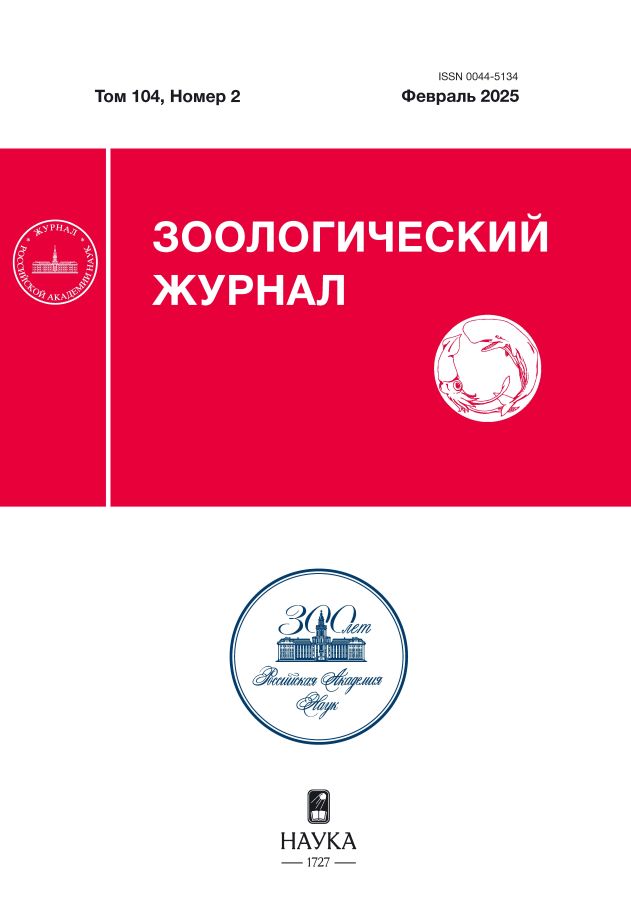A statistical analysis of long-term changes in the numbers of the Bank vole, Clethrionomys glareolus Schreber, in the Northwest of its distribution area
- Авторлар: Ivanter E.V.1,2
-
Мекемелер:
- Karelian Research Centre, Russian Academy of Sciences
- Petrozavodsk State University
- Шығарылым: Том 104, № 2 (2025)
- Беттер: 96-102
- Бөлім: ARTICLES
- URL: https://freezetech.ru/0044-5134/article/view/684678
- DOI: https://doi.org/10.31857/S0044513425020073
- EDN: https://elibrary.ru/ssndbt
- ID: 684678
Дәйексөз келтіру
Аннотация
Changes in Bank vole numbers were analyzed based on long-term observations (1965–2014). Material (4925 specimens) was collected in Karelia using standard methods. That fundamental habitat was chosen to avoid the influence of succession changes on mammal numbers. Both autocorrelation and spectral (harmonic) analyses were applied. The study shows that the mechanisms of restraining the population growth start at the level of 2.2 s./100 cage-24 hours. Analyses of averaged data for the May–September period, as well as for the period of maximum abundance (August) yielded similar results. Correlation analysis revealed periodicity in temporal series, based only on groove capture data (4–6 years). Harmonic analysis showed 6- to 9-year long intervals in rodent numbers change. Recurrence was low in the conditions of Karelia, as well as over most of the distribution area. Analyses of changes in Bank vole abundance in a single fundamental forest type in August revealed a more evident frequency than those using generalized data covering different habitats.
Негізгі сөздер
Толық мәтін
Авторлар туралы
E. Ivanter
Karelian Research Centre, Russian Academy of Sciences; Petrozavodsk State University
Хат алмасуға жауапты Автор.
Email: ivanter@petrsu.ru
Ресей, Petrozavodsk, 185035; Petrozavodsk, 185910
Әдебиет тізімі
- Базыкин А. Д., 1969. Модели динамики численности и проблема сосуществования близких видов животных // Журнал общей биологии. Т. 30. № 3. С. 259– 318.
- Базыкин А. Д., 1985. Математическое моделирование и анализ популяционных механизмов взаимодействия животных. М.: Наука. 453 с.
- Балакирев А. Е., Окулова Н. М., Ивантер Э. В., 2004. К анализу факторных воздействий на многолетнюю динамику численности обыкновенной бурозубки на севере и юге ареала // Поволжский экологический журнал. № 3. С. 111–122.
- Дженкинс Г., Ваттс Д., 1971. Спектральный анализ и его приложение. Вып. 1. М.: Мир. 317 с.
- Захаров В. М., Шефтель Б. И., Дмитриев С. Г., 2011. Изменение климата и популяционная динамика: возможные последствия (на примере мелких млекопитающих в Центральной Сибири // Успехи современной биологии. Т. 31. № 5. С. 435–442.
- Ивантер Э. В., 1975. Популяционная экология мелких млекопитающих таежного Северо-Запада СССР. Л.: Наука. 247 с.
- Ивантер Э. В., 2018. Очерки популяционной экологии мелких млекопитающих на северной периферии ареала. М.: Товарищество научных изданий КМК. 770 с.
- Ивантер Э. В., Коросов А. В., Якимова А. Е., 2015. Эколого-статистический анализ многолетних изменений численности мелких млекопитающих на северном пределе ареала (Северо-Восточное Приладожье) // Экология. № 1. С. 57–63.
- Ивантер Э. В., Макаров А. М., Крюкова С. А., 2017. Опыт статистического анализа многолетних изменений численности обыкновенной бурозубки (Sorex araneus) на северной периферии ареала // Зоологический журнал. Т. 96. № 9. С. 1098–1105.
- Коросов А. В., 2002. Имитационное моделирование в среде MSExcel (на примерах из экологии). Петрозаводск: Изд. ПетрГу. 343 с.
- Орлов В. А., Саранча Д. А., Шелепова Т. В., 1986. Математическая модель динамики численности популяции леммингов (Lemmus, Dicrostomys) и ее использование для описания популяций Восточного Таймыра // Экология. № 2. С. 43–51.
- Пузаченко Ю. Г., 2004. Математические методы экологических и географических исследований. М.: Академия. 411 с.
- Рикер У. Е., 1979. Методы оценки и моделирования биологических показателей. М.: Пищепромиздат. 123 с.
- Саранча Д. А., 1991. Экологические принципы // Биомоделирование. М.: ВЦ РАН. С. 156–176.
- Саранча Д.А,. 1995. Биомоделирование. Материалы по количественной экологии. Математическое моделирование и биофизические аспекты. М.: ВЦ РАН. 139 с.
- Саранча Д. А., 1997. Количественные методы в экологии. Биофизические аспекты и математическое моделирование. М.: МФТИ. 283 с.
- Саранча Д. А., 2004. Математические модели экосистем. Неавтономные математические модели экологических систем. М.: Наука. 413 с.
- Фрисман Е. Я., 1991. Математическое моделирование и анализ механизмов популяционной динамики промысловых животных. Владивосток. 425 с.
- Hanski I., Hentonen H., Korpimäki E. et al., 2001. Small-rodent dynamics and predation // Ecology. V. 82. P. 1505–1520.
- Hansson L., 1989. Dynamics and trophic interaction of small rodents landscape or regional effects on spatial variation? // Oecologia. V. 130. P. 259–266.
- Hansson L., Henttonen H., 1989. Rodents, predation and wildlife cycles // Finnish Game Res. V. 46. P. 26–33.
- Hentonen H., Tast J., Viitala J., Kaikusalo A., 1988. Ecology of cyclic rodents in northern Binland // Memeoranda Soc. Fauna a. Flora Fennica. V. 25. P. 61–77.
Қосымша файлдар












